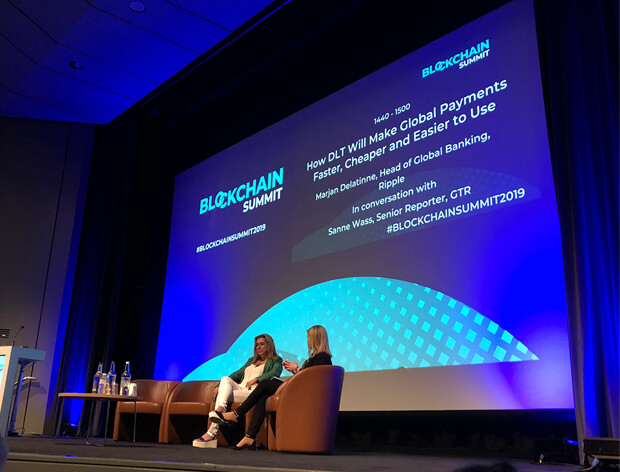With experience of working at both Swift and Ripple, Marjan Delatinne is uniquely placed to answer questions about the evolution of the cross-border payments market.
In an on-stage interview at the Blockchain Summit last week, Delatinne, Ripple’s global head of banking, spoke to GTR’s Sanne Wass about two of Ripple’s offerings, the company’s work with banks, Swift’s global payments innovation (gpi) service and Facebook’s Libra announcement.
Delatinne, who joined Ripple in 2017, previously worked at Swift for 10 years, most recently in charge of selling the gpi.
GTR: What has been the most significant development for Ripple over the past 12 months?
Delatinne: I think the most significant development happened last week. We have committed a US$50mn investment in MoneyGram, which is very important news for us. MoneyGram is one of the largest payment service providers worldwide. It has a very big footprint on the remittances business, and more importantly, it is going to use one of our key products, xRapid, to transfer funds.
GTR: You already have a product called xCurrent. Your second product, xRapid, was made commercially available in October. What is the difference between the two solutions and the problems they are trying to solve?
Delatinne: There is a lot of confusion about that. Most importantly, what we are building is a network: a decentralised, cross-border network.
xCurrent is our core product. We have more than 200 customers using it, and we sign on average three to five institutions a week. xCurrent is really around exchanging value fiat to fiat, so it’s business as usual, but you are using the power of distributed ledger technology – with the speed, the data management and reconciliation capacity that the technology provides – in order to have a better service for the customers.
But we don’t talk enough about liquidity, and this is where the real cost of cross-border payments exists. Today trillions of dollars are tied up in pre-funded accounts around the world by banks in order to make sure that the exchange of value in the correspondent banking system is happening. But it’s at a cost: working capital for corporates is locked up.
The use case that we have around xRapid is that, rather than tying up capital, we reconcile the transfer of the messages and the value itself. xRapid is about sourcing on-demand liquidity. It’s not around trying to push financial institutions to use or buy cryptocurrency, but it’s using cryptocurrency, in this case our native digital asset XRP, as a bridge currency between two fiat currencies. This is helping users to have fast and low-cost provision of liquidity when they need it, without the obligation of tying up capital in advance in pre-funded accounts. xRapid went live last October, so it’s a very new product, but we have more than 20 financial institutions using it.
GTR: What’s it like selling xRapid to banks? On the one hand blockchain is a buzzword that banks are very keen to be associated with; on the other, they seem very cautious when it comes to implementing anything to do with cryptocurrencies. Is that a challenge that you face?
Delatinne: Of course. We are obviously in an education phase. When talking with banks, we still have to ensure that they understand that using this product is not around keeping XRP on their balance sheets. That’s very important for the banks to understand, because they would otherwise have to report that to the regulators.
So there is still a lot of education, but what is apparent with the regional banks and also the payment service providers is that they are hungry for change and for having a competitive edge. That’s really the driver: being able to source on-demand liquidity and providing a real-time experience in terms of cross-border payments. For some difficult corridors, for instance the Mexican peso and Philippine peso, a transaction currently takes three to four days, because the underlying process is still archaic.
Payment service providers are agile, they don’t have legacies, they can easily embrace new technology and they see the value in our solution. With the more, say, incumbent players, we really need to go through the education phase, but we see an improvement compared to two years ago, where blockchain or cryptocurrency was seen as just for illicit purposes – this has changed.
GTR: Speaking about the incumbents. Many banks today rely on Swift for their cross-border payments. You have worked on Swift’s most recent innovation, the gpi, which promises faster settlement times and more transparency. Swift says gpi is successful and now aims to sign up all of its bank members, which is more than 10,000, by 2020. Ripple, meanwhile, has a couple of hundred bank clients. Is Ripple a competitor to Swift?
Delatinne: Personally, because I have been on both sides, I don’t think that we are competitors. We are two different things and at the end of the day, it’s about what brings value to the users. Swift is improving dramatically the way that the payments happen today, but it’s still about the messaging. You still send a message to another party. I don’t call it settlement, because this is not settlement, it’s around the fact that I can send a message in a faster way, and I can track it. This is an improvement from previously, where it could take days. So it is bringing a value.
But it’s still decoupling the transfer of the messages, which are information around the payment, and the value itself. gpi is sending information. But with the distributed ledger, you can make the settlement at the same time.
We are not replacing Swift, as Swift has its own value and I think we can be very complementary. It comes back to what is best for the community and how they can take advantage of both.
GTR: So Swift has nothing to worry about?
Delatinne: You should be worried about anything in this world.
GTR: What do you think of Facebook’s recent announcement of its new Libra cryptocurrency? Are you worried about competition?
Delatinne: Obviously I think it is great news that a company like Facebook enters this space. JP Morgan did a couple of months ago. All of this brings more credibility to this space, especially when you are talking about money. I know that blockchain is used for different use cases, but when you are talking about value, this is a very political space with lots of regulatory oversight. So the more names, the better. For us, it’s just a validation of what we have been saying for seven years.
Facebook’s business model is slightly different from ours. They are working in the consumer space, where they have the network. Of course at this stage Libra doesn’t exist, it’s just a whitepaper, but Facebook has started with a vision, and this vision will probably evolve over time, but what we see is that their approach is not necessarily that they are going to work with the financial system – they want to completely transform it and bring a completely different experience. Our approach is different: we are working with the system, so we haven’t been disrupting only. We are happily working with the banks, the payment service providers and the regulators.
GTR: Finally, what are the future plans for Ripple? What will we be talking about a year from now?
Delatinne: Now our focus in on the critical mass that we are building in terms of users. The first priority for us is volumes. If I compare to two years ago when the network went live, it is amazing: the network is really growing fast, and you see the network effects with the numbers that are added on a weekly basis. We are continuing to build this momentum.







